Digital Business & E-commerce: Technologies and Development
VerifiedAdded on 2023/06/11
|9
|2702
|425
Report
AI Summary
This report explores the significance, development, and technologies used in e-commerce, highlighting its role as a business tool. It discusses the importance of e-commerce in expanding market reach and reducing costs, detailing technologies like AI, chatbots, and voice assistants, along with various e-commerce platforms. The report also examines the relationship between digital technologies and both new and established business management theories, such as decision-making and contingency theory, illustrating how these theories apply to e-commerce business models like B2C and B2B. It emphasizes the need for businesses to make informed decisions regarding technology adoption and adapt to internal and external factors to remain competitive. Desklib provides this and many more solved assignments for students.
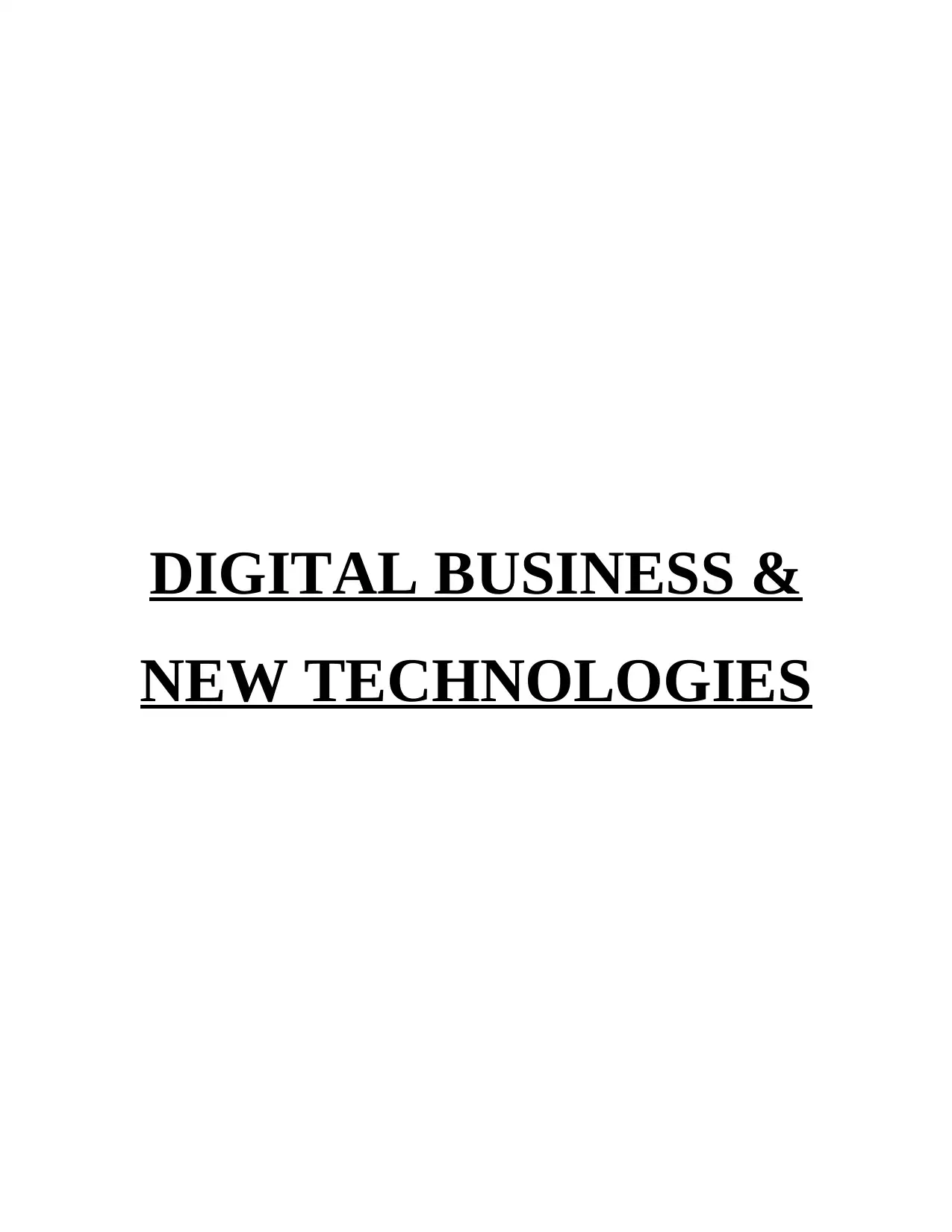
DIGITAL BUSINESS &
NEW TECHNOLOGIES
NEW TECHNOLOGIES
Paraphrase This Document
Need a fresh take? Get an instant paraphrase of this document with our AI Paraphraser
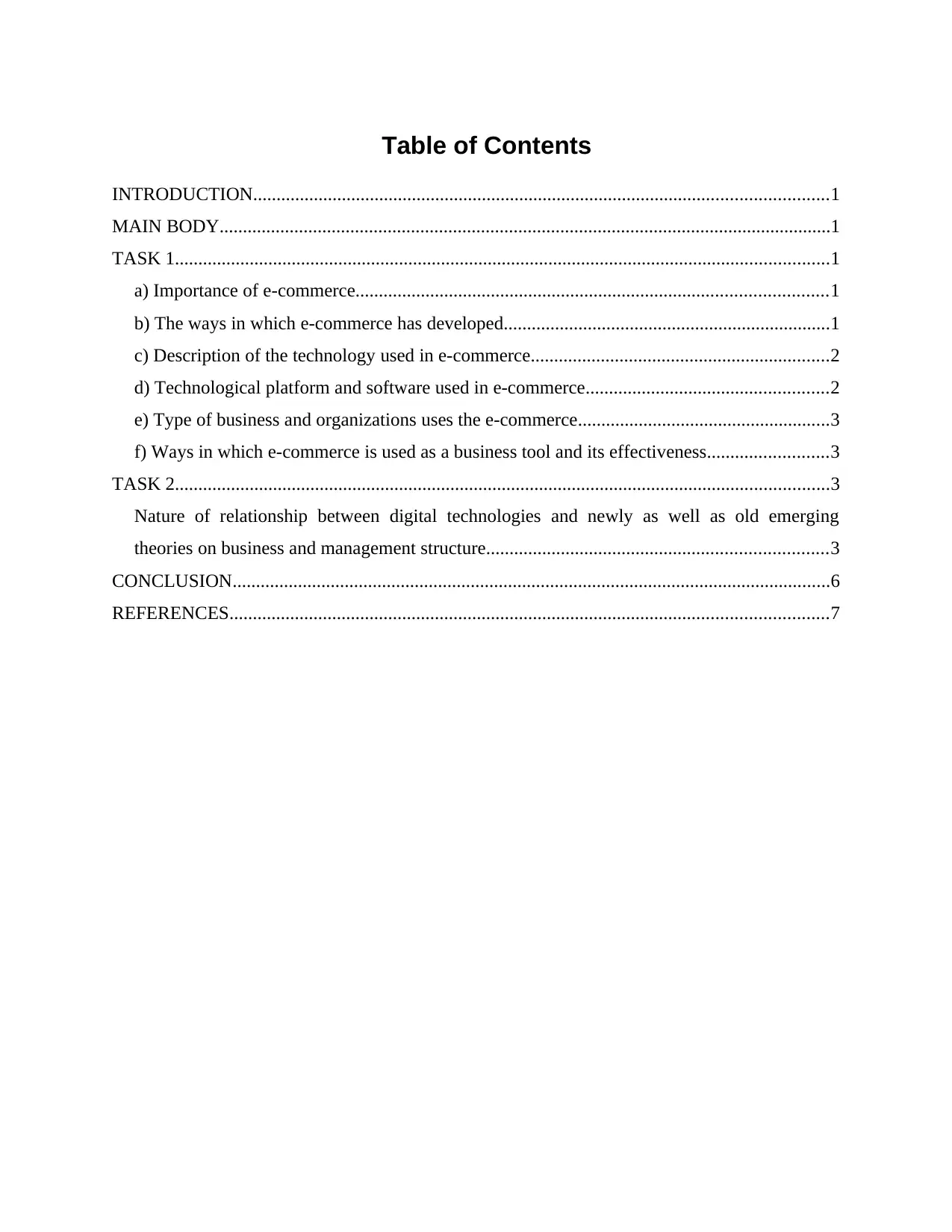
Table of Contents
INTRODUCTION...........................................................................................................................1
MAIN BODY...................................................................................................................................1
TASK 1............................................................................................................................................1
a) Importance of e-commerce.....................................................................................................1
b) The ways in which e-commerce has developed......................................................................1
c) Description of the technology used in e-commerce................................................................2
d) Technological platform and software used in e-commerce....................................................2
e) Type of business and organizations uses the e-commerce......................................................3
f) Ways in which e-commerce is used as a business tool and its effectiveness..........................3
TASK 2............................................................................................................................................3
Nature of relationship between digital technologies and newly as well as old emerging
theories on business and management structure.........................................................................3
CONCLUSION................................................................................................................................6
REFERENCES................................................................................................................................7
INTRODUCTION...........................................................................................................................1
MAIN BODY...................................................................................................................................1
TASK 1............................................................................................................................................1
a) Importance of e-commerce.....................................................................................................1
b) The ways in which e-commerce has developed......................................................................1
c) Description of the technology used in e-commerce................................................................2
d) Technological platform and software used in e-commerce....................................................2
e) Type of business and organizations uses the e-commerce......................................................3
f) Ways in which e-commerce is used as a business tool and its effectiveness..........................3
TASK 2............................................................................................................................................3
Nature of relationship between digital technologies and newly as well as old emerging
theories on business and management structure.........................................................................3
CONCLUSION................................................................................................................................6
REFERENCES................................................................................................................................7
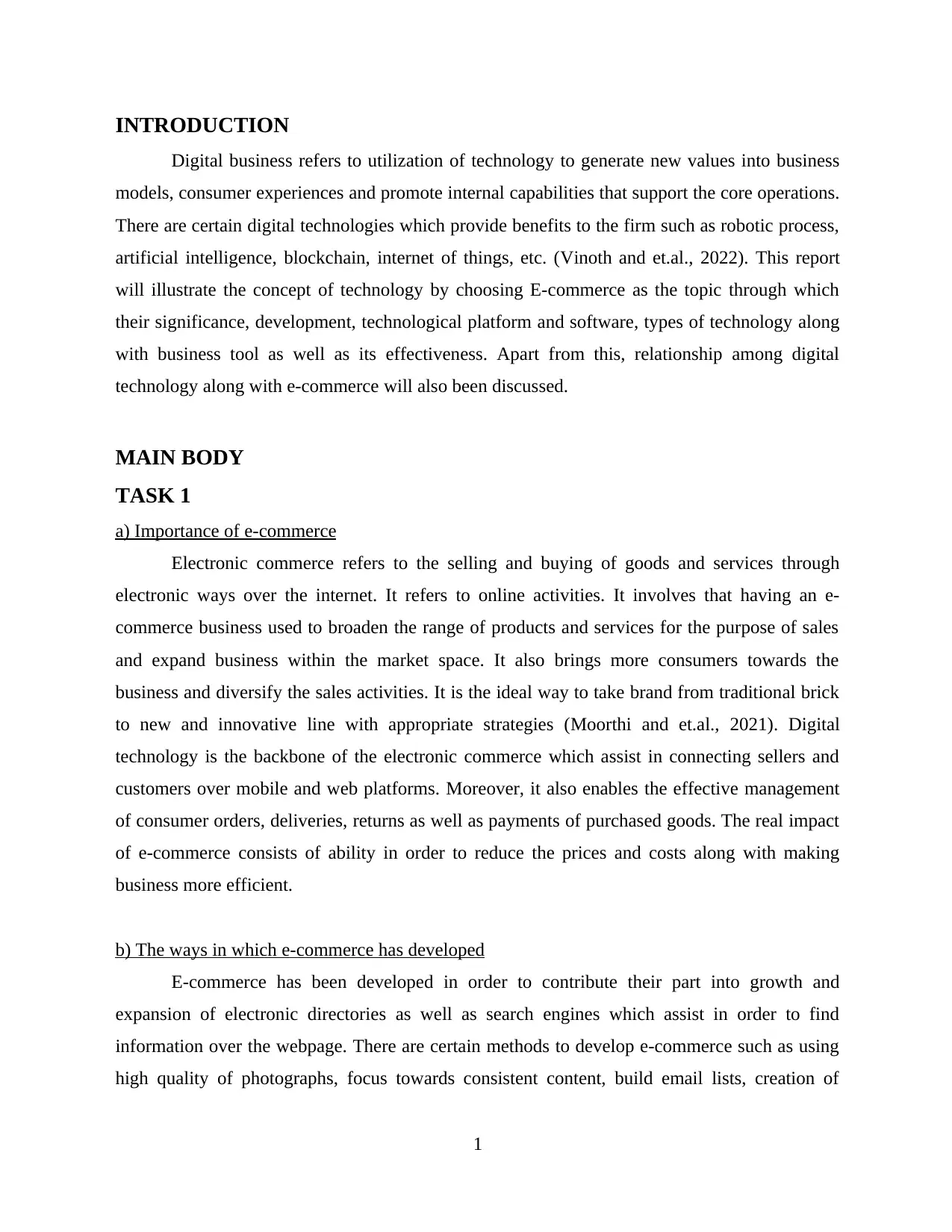
INTRODUCTION
Digital business refers to utilization of technology to generate new values into business
models, consumer experiences and promote internal capabilities that support the core operations.
There are certain digital technologies which provide benefits to the firm such as robotic process,
artificial intelligence, blockchain, internet of things, etc. (Vinoth and et.al., 2022). This report
will illustrate the concept of technology by choosing E-commerce as the topic through which
their significance, development, technological platform and software, types of technology along
with business tool as well as its effectiveness. Apart from this, relationship among digital
technology along with e-commerce will also been discussed.
MAIN BODY
TASK 1
a) Importance of e-commerce
Electronic commerce refers to the selling and buying of goods and services through
electronic ways over the internet. It refers to online activities. It involves that having an e-
commerce business used to broaden the range of products and services for the purpose of sales
and expand business within the market space. It also brings more consumers towards the
business and diversify the sales activities. It is the ideal way to take brand from traditional brick
to new and innovative line with appropriate strategies (Moorthi and et.al., 2021). Digital
technology is the backbone of the electronic commerce which assist in connecting sellers and
customers over mobile and web platforms. Moreover, it also enables the effective management
of consumer orders, deliveries, returns as well as payments of purchased goods. The real impact
of e-commerce consists of ability in order to reduce the prices and costs along with making
business more efficient.
b) The ways in which e-commerce has developed
E-commerce has been developed in order to contribute their part into growth and
expansion of electronic directories as well as search engines which assist in order to find
information over the webpage. There are certain methods to develop e-commerce such as using
high quality of photographs, focus towards consistent content, build email lists, creation of
1
Digital business refers to utilization of technology to generate new values into business
models, consumer experiences and promote internal capabilities that support the core operations.
There are certain digital technologies which provide benefits to the firm such as robotic process,
artificial intelligence, blockchain, internet of things, etc. (Vinoth and et.al., 2022). This report
will illustrate the concept of technology by choosing E-commerce as the topic through which
their significance, development, technological platform and software, types of technology along
with business tool as well as its effectiveness. Apart from this, relationship among digital
technology along with e-commerce will also been discussed.
MAIN BODY
TASK 1
a) Importance of e-commerce
Electronic commerce refers to the selling and buying of goods and services through
electronic ways over the internet. It refers to online activities. It involves that having an e-
commerce business used to broaden the range of products and services for the purpose of sales
and expand business within the market space. It also brings more consumers towards the
business and diversify the sales activities. It is the ideal way to take brand from traditional brick
to new and innovative line with appropriate strategies (Moorthi and et.al., 2021). Digital
technology is the backbone of the electronic commerce which assist in connecting sellers and
customers over mobile and web platforms. Moreover, it also enables the effective management
of consumer orders, deliveries, returns as well as payments of purchased goods. The real impact
of e-commerce consists of ability in order to reduce the prices and costs along with making
business more efficient.
b) The ways in which e-commerce has developed
E-commerce has been developed in order to contribute their part into growth and
expansion of electronic directories as well as search engines which assist in order to find
information over the webpage. There are certain methods to develop e-commerce such as using
high quality of photographs, focus towards consistent content, build email lists, creation of
1
⊘ This is a preview!⊘
Do you want full access?
Subscribe today to unlock all pages.

Trusted by 1+ million students worldwide
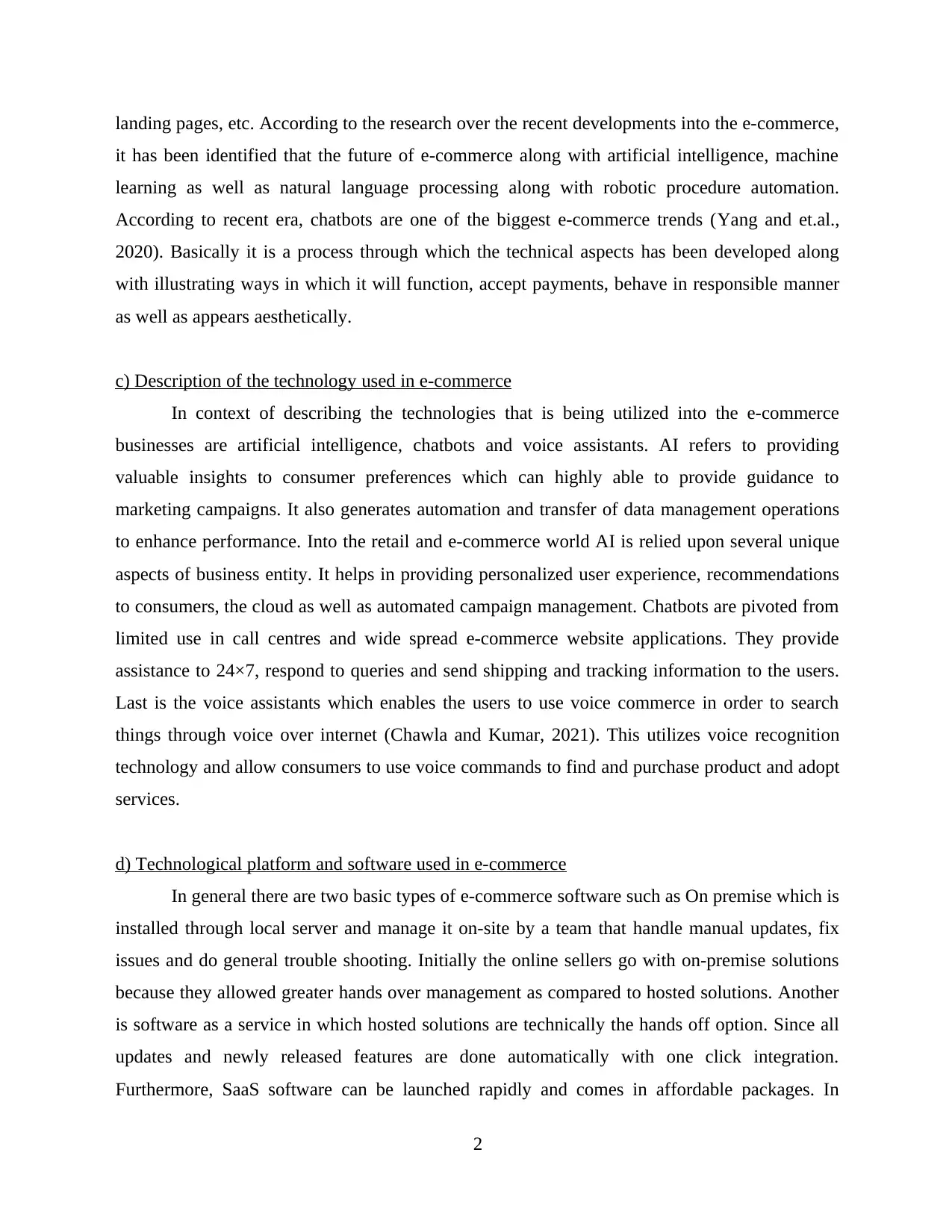
landing pages, etc. According to the research over the recent developments into the e-commerce,
it has been identified that the future of e-commerce along with artificial intelligence, machine
learning as well as natural language processing along with robotic procedure automation.
According to recent era, chatbots are one of the biggest e-commerce trends (Yang and et.al.,
2020). Basically it is a process through which the technical aspects has been developed along
with illustrating ways in which it will function, accept payments, behave in responsible manner
as well as appears aesthetically.
c) Description of the technology used in e-commerce
In context of describing the technologies that is being utilized into the e-commerce
businesses are artificial intelligence, chatbots and voice assistants. AI refers to providing
valuable insights to consumer preferences which can highly able to provide guidance to
marketing campaigns. It also generates automation and transfer of data management operations
to enhance performance. Into the retail and e-commerce world AI is relied upon several unique
aspects of business entity. It helps in providing personalized user experience, recommendations
to consumers, the cloud as well as automated campaign management. Chatbots are pivoted from
limited use in call centres and wide spread e-commerce website applications. They provide
assistance to 24×7, respond to queries and send shipping and tracking information to the users.
Last is the voice assistants which enables the users to use voice commerce in order to search
things through voice over internet (Chawla and Kumar, 2021). This utilizes voice recognition
technology and allow consumers to use voice commands to find and purchase product and adopt
services.
d) Technological platform and software used in e-commerce
In general there are two basic types of e-commerce software such as On premise which is
installed through local server and manage it on-site by a team that handle manual updates, fix
issues and do general trouble shooting. Initially the online sellers go with on-premise solutions
because they allowed greater hands over management as compared to hosted solutions. Another
is software as a service in which hosted solutions are technically the hands off option. Since all
updates and newly released features are done automatically with one click integration.
Furthermore, SaaS software can be launched rapidly and comes in affordable packages. In
2
it has been identified that the future of e-commerce along with artificial intelligence, machine
learning as well as natural language processing along with robotic procedure automation.
According to recent era, chatbots are one of the biggest e-commerce trends (Yang and et.al.,
2020). Basically it is a process through which the technical aspects has been developed along
with illustrating ways in which it will function, accept payments, behave in responsible manner
as well as appears aesthetically.
c) Description of the technology used in e-commerce
In context of describing the technologies that is being utilized into the e-commerce
businesses are artificial intelligence, chatbots and voice assistants. AI refers to providing
valuable insights to consumer preferences which can highly able to provide guidance to
marketing campaigns. It also generates automation and transfer of data management operations
to enhance performance. Into the retail and e-commerce world AI is relied upon several unique
aspects of business entity. It helps in providing personalized user experience, recommendations
to consumers, the cloud as well as automated campaign management. Chatbots are pivoted from
limited use in call centres and wide spread e-commerce website applications. They provide
assistance to 24×7, respond to queries and send shipping and tracking information to the users.
Last is the voice assistants which enables the users to use voice commerce in order to search
things through voice over internet (Chawla and Kumar, 2021). This utilizes voice recognition
technology and allow consumers to use voice commands to find and purchase product and adopt
services.
d) Technological platform and software used in e-commerce
In general there are two basic types of e-commerce software such as On premise which is
installed through local server and manage it on-site by a team that handle manual updates, fix
issues and do general trouble shooting. Initially the online sellers go with on-premise solutions
because they allowed greater hands over management as compared to hosted solutions. Another
is software as a service in which hosted solutions are technically the hands off option. Since all
updates and newly released features are done automatically with one click integration.
Furthermore, SaaS software can be launched rapidly and comes in affordable packages. In
2
Paraphrase This Document
Need a fresh take? Get an instant paraphrase of this document with our AI Paraphraser
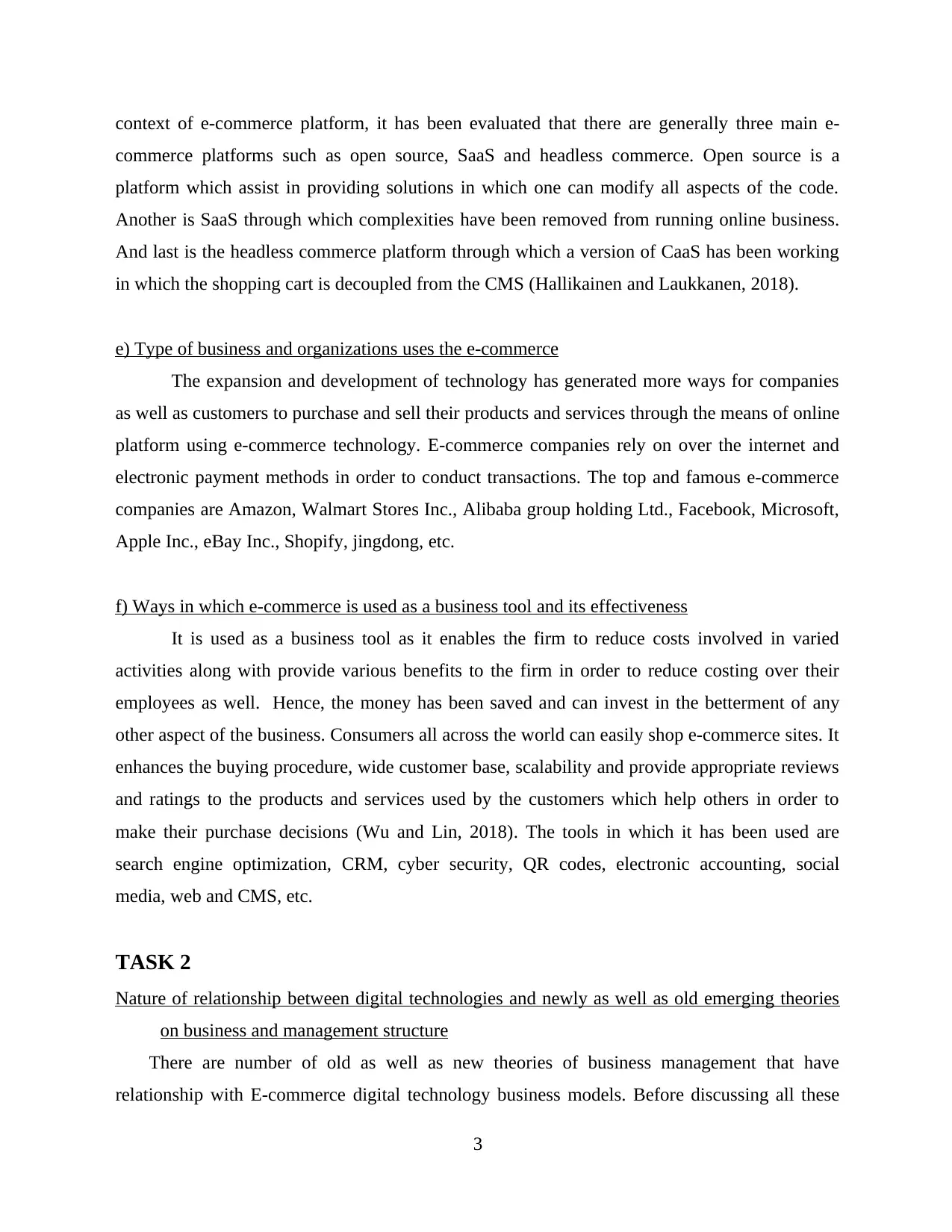
context of e-commerce platform, it has been evaluated that there are generally three main e-
commerce platforms such as open source, SaaS and headless commerce. Open source is a
platform which assist in providing solutions in which one can modify all aspects of the code.
Another is SaaS through which complexities have been removed from running online business.
And last is the headless commerce platform through which a version of CaaS has been working
in which the shopping cart is decoupled from the CMS (Hallikainen and Laukkanen, 2018).
e) Type of business and organizations uses the e-commerce
The expansion and development of technology has generated more ways for companies
as well as customers to purchase and sell their products and services through the means of online
platform using e-commerce technology. E-commerce companies rely on over the internet and
electronic payment methods in order to conduct transactions. The top and famous e-commerce
companies are Amazon, Walmart Stores Inc., Alibaba group holding Ltd., Facebook, Microsoft,
Apple Inc., eBay Inc., Shopify, jingdong, etc.
f) Ways in which e-commerce is used as a business tool and its effectiveness
It is used as a business tool as it enables the firm to reduce costs involved in varied
activities along with provide various benefits to the firm in order to reduce costing over their
employees as well. Hence, the money has been saved and can invest in the betterment of any
other aspect of the business. Consumers all across the world can easily shop e-commerce sites. It
enhances the buying procedure, wide customer base, scalability and provide appropriate reviews
and ratings to the products and services used by the customers which help others in order to
make their purchase decisions (Wu and Lin, 2018). The tools in which it has been used are
search engine optimization, CRM, cyber security, QR codes, electronic accounting, social
media, web and CMS, etc.
TASK 2
Nature of relationship between digital technologies and newly as well as old emerging theories
on business and management structure
There are number of old as well as new theories of business management that have
relationship with E-commerce digital technology business models. Before discussing all these
3
commerce platforms such as open source, SaaS and headless commerce. Open source is a
platform which assist in providing solutions in which one can modify all aspects of the code.
Another is SaaS through which complexities have been removed from running online business.
And last is the headless commerce platform through which a version of CaaS has been working
in which the shopping cart is decoupled from the CMS (Hallikainen and Laukkanen, 2018).
e) Type of business and organizations uses the e-commerce
The expansion and development of technology has generated more ways for companies
as well as customers to purchase and sell their products and services through the means of online
platform using e-commerce technology. E-commerce companies rely on over the internet and
electronic payment methods in order to conduct transactions. The top and famous e-commerce
companies are Amazon, Walmart Stores Inc., Alibaba group holding Ltd., Facebook, Microsoft,
Apple Inc., eBay Inc., Shopify, jingdong, etc.
f) Ways in which e-commerce is used as a business tool and its effectiveness
It is used as a business tool as it enables the firm to reduce costs involved in varied
activities along with provide various benefits to the firm in order to reduce costing over their
employees as well. Hence, the money has been saved and can invest in the betterment of any
other aspect of the business. Consumers all across the world can easily shop e-commerce sites. It
enhances the buying procedure, wide customer base, scalability and provide appropriate reviews
and ratings to the products and services used by the customers which help others in order to
make their purchase decisions (Wu and Lin, 2018). The tools in which it has been used are
search engine optimization, CRM, cyber security, QR codes, electronic accounting, social
media, web and CMS, etc.
TASK 2
Nature of relationship between digital technologies and newly as well as old emerging theories
on business and management structure
There are number of old as well as new theories of business management that have
relationship with E-commerce digital technology business models. Before discussing all these
3
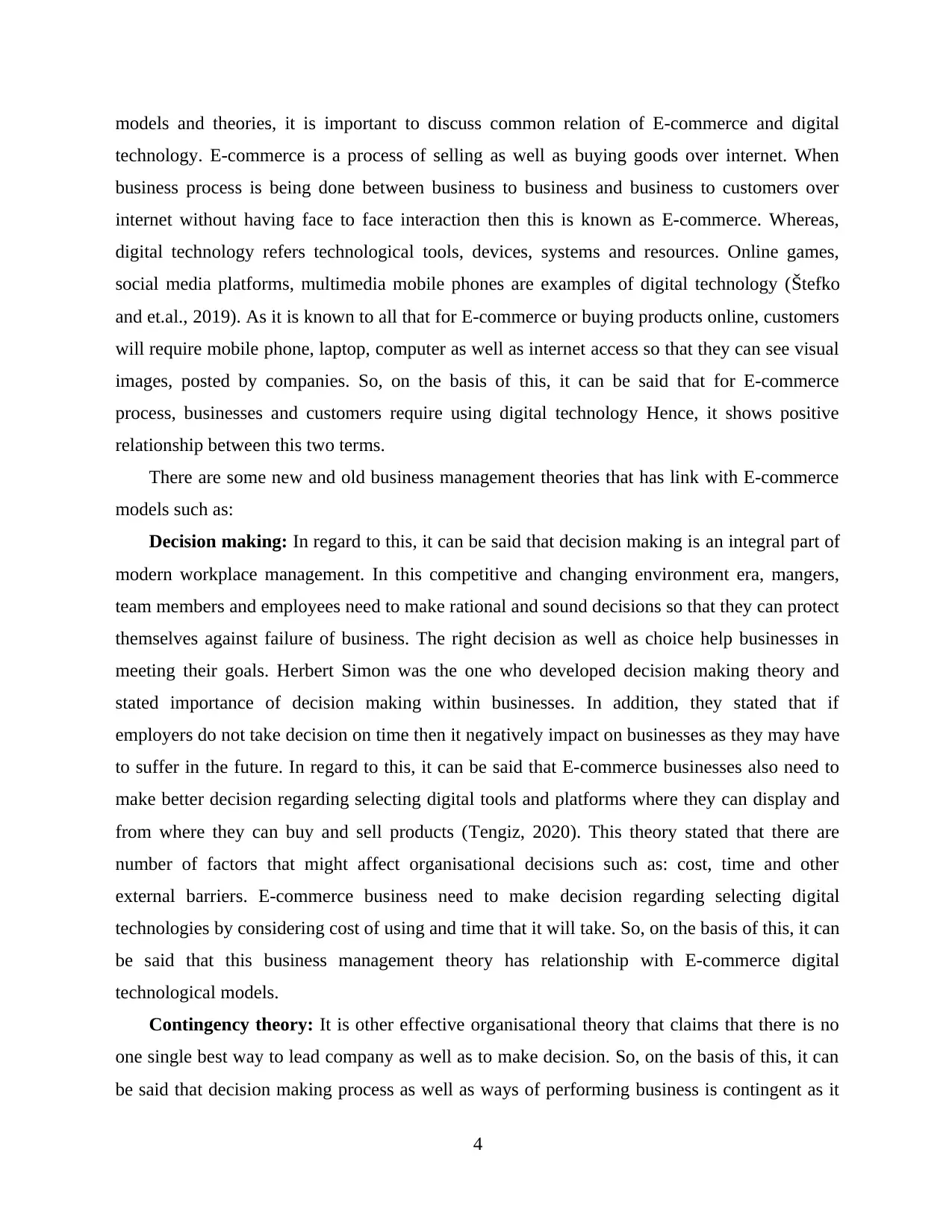
models and theories, it is important to discuss common relation of E-commerce and digital
technology. E-commerce is a process of selling as well as buying goods over internet. When
business process is being done between business to business and business to customers over
internet without having face to face interaction then this is known as E-commerce. Whereas,
digital technology refers technological tools, devices, systems and resources. Online games,
social media platforms, multimedia mobile phones are examples of digital technology (Štefko
and et.al., 2019). As it is known to all that for E-commerce or buying products online, customers
will require mobile phone, laptop, computer as well as internet access so that they can see visual
images, posted by companies. So, on the basis of this, it can be said that for E-commerce
process, businesses and customers require using digital technology Hence, it shows positive
relationship between this two terms.
There are some new and old business management theories that has link with E-commerce
models such as:
Decision making: In regard to this, it can be said that decision making is an integral part of
modern workplace management. In this competitive and changing environment era, mangers,
team members and employees need to make rational and sound decisions so that they can protect
themselves against failure of business. The right decision as well as choice help businesses in
meeting their goals. Herbert Simon was the one who developed decision making theory and
stated importance of decision making within businesses. In addition, they stated that if
employers do not take decision on time then it negatively impact on businesses as they may have
to suffer in the future. In regard to this, it can be said that E-commerce businesses also need to
make better decision regarding selecting digital tools and platforms where they can display and
from where they can buy and sell products (Tengiz, 2020). This theory stated that there are
number of factors that might affect organisational decisions such as: cost, time and other
external barriers. E-commerce business need to make decision regarding selecting digital
technologies by considering cost of using and time that it will take. So, on the basis of this, it can
be said that this business management theory has relationship with E-commerce digital
technological models.
Contingency theory: It is other effective organisational theory that claims that there is no
one single best way to lead company as well as to make decision. So, on the basis of this, it can
be said that decision making process as well as ways of performing business is contingent as it
4
technology. E-commerce is a process of selling as well as buying goods over internet. When
business process is being done between business to business and business to customers over
internet without having face to face interaction then this is known as E-commerce. Whereas,
digital technology refers technological tools, devices, systems and resources. Online games,
social media platforms, multimedia mobile phones are examples of digital technology (Štefko
and et.al., 2019). As it is known to all that for E-commerce or buying products online, customers
will require mobile phone, laptop, computer as well as internet access so that they can see visual
images, posted by companies. So, on the basis of this, it can be said that for E-commerce
process, businesses and customers require using digital technology Hence, it shows positive
relationship between this two terms.
There are some new and old business management theories that has link with E-commerce
models such as:
Decision making: In regard to this, it can be said that decision making is an integral part of
modern workplace management. In this competitive and changing environment era, mangers,
team members and employees need to make rational and sound decisions so that they can protect
themselves against failure of business. The right decision as well as choice help businesses in
meeting their goals. Herbert Simon was the one who developed decision making theory and
stated importance of decision making within businesses. In addition, they stated that if
employers do not take decision on time then it negatively impact on businesses as they may have
to suffer in the future. In regard to this, it can be said that E-commerce businesses also need to
make better decision regarding selecting digital tools and platforms where they can display and
from where they can buy and sell products (Tengiz, 2020). This theory stated that there are
number of factors that might affect organisational decisions such as: cost, time and other
external barriers. E-commerce business need to make decision regarding selecting digital
technologies by considering cost of using and time that it will take. So, on the basis of this, it can
be said that this business management theory has relationship with E-commerce digital
technological models.
Contingency theory: It is other effective organisational theory that claims that there is no
one single best way to lead company as well as to make decision. So, on the basis of this, it can
be said that decision making process as well as ways of performing business is contingent as it
4
⊘ This is a preview!⊘
Do you want full access?
Subscribe today to unlock all pages.

Trusted by 1+ million students worldwide
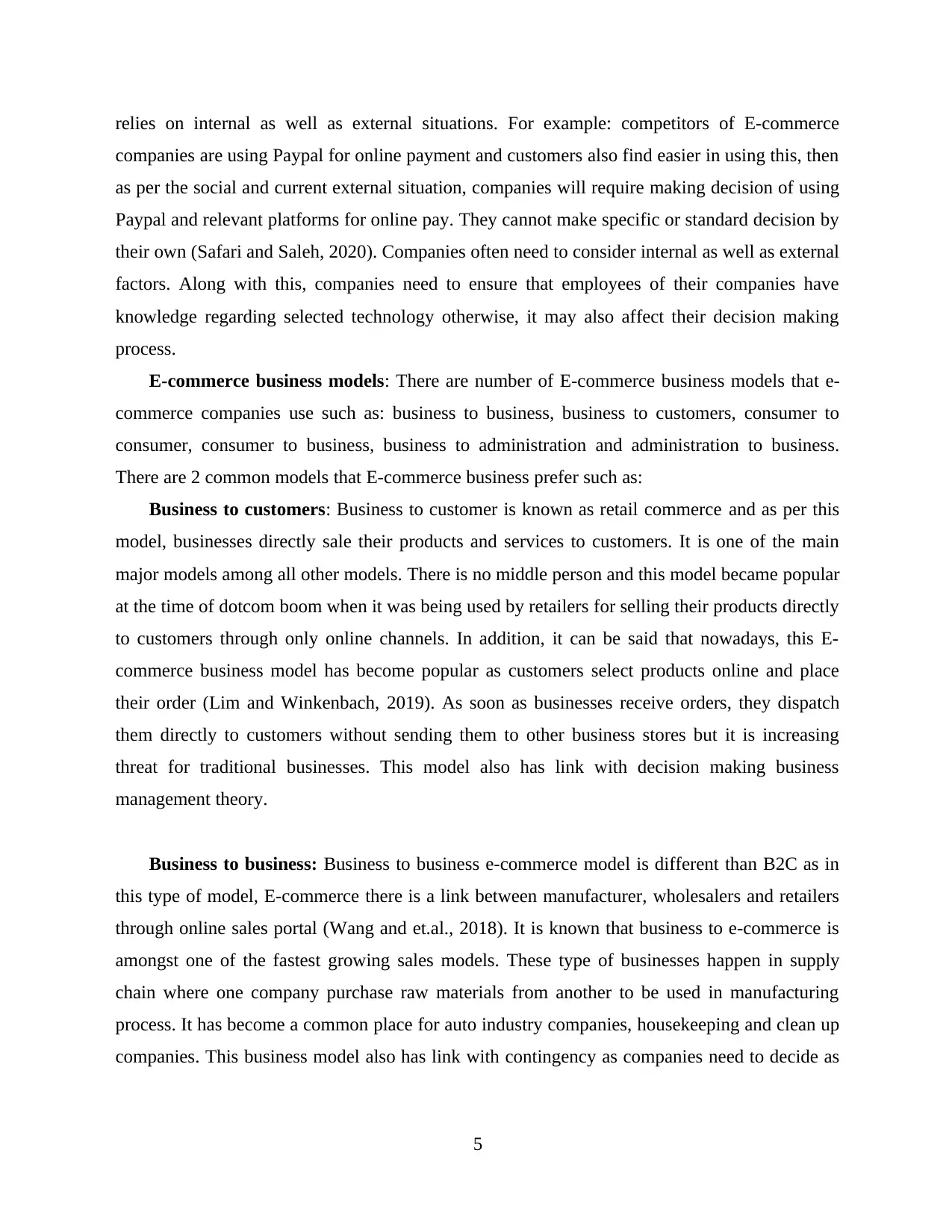
relies on internal as well as external situations. For example: competitors of E-commerce
companies are using Paypal for online payment and customers also find easier in using this, then
as per the social and current external situation, companies will require making decision of using
Paypal and relevant platforms for online pay. They cannot make specific or standard decision by
their own (Safari and Saleh, 2020). Companies often need to consider internal as well as external
factors. Along with this, companies need to ensure that employees of their companies have
knowledge regarding selected technology otherwise, it may also affect their decision making
process.
E-commerce business models: There are number of E-commerce business models that e-
commerce companies use such as: business to business, business to customers, consumer to
consumer, consumer to business, business to administration and administration to business.
There are 2 common models that E-commerce business prefer such as:
Business to customers: Business to customer is known as retail commerce and as per this
model, businesses directly sale their products and services to customers. It is one of the main
major models among all other models. There is no middle person and this model became popular
at the time of dotcom boom when it was being used by retailers for selling their products directly
to customers through only online channels. In addition, it can be said that nowadays, this E-
commerce business model has become popular as customers select products online and place
their order (Lim and Winkenbach, 2019). As soon as businesses receive orders, they dispatch
them directly to customers without sending them to other business stores but it is increasing
threat for traditional businesses. This model also has link with decision making business
management theory.
Business to business: Business to business e-commerce model is different than B2C as in
this type of model, E-commerce there is a link between manufacturer, wholesalers and retailers
through online sales portal (Wang and et.al., 2018). It is known that business to e-commerce is
amongst one of the fastest growing sales models. These type of businesses happen in supply
chain where one company purchase raw materials from another to be used in manufacturing
process. It has become a common place for auto industry companies, housekeeping and clean up
companies. This business model also has link with contingency as companies need to decide as
5
companies are using Paypal for online payment and customers also find easier in using this, then
as per the social and current external situation, companies will require making decision of using
Paypal and relevant platforms for online pay. They cannot make specific or standard decision by
their own (Safari and Saleh, 2020). Companies often need to consider internal as well as external
factors. Along with this, companies need to ensure that employees of their companies have
knowledge regarding selected technology otherwise, it may also affect their decision making
process.
E-commerce business models: There are number of E-commerce business models that e-
commerce companies use such as: business to business, business to customers, consumer to
consumer, consumer to business, business to administration and administration to business.
There are 2 common models that E-commerce business prefer such as:
Business to customers: Business to customer is known as retail commerce and as per this
model, businesses directly sale their products and services to customers. It is one of the main
major models among all other models. There is no middle person and this model became popular
at the time of dotcom boom when it was being used by retailers for selling their products directly
to customers through only online channels. In addition, it can be said that nowadays, this E-
commerce business model has become popular as customers select products online and place
their order (Lim and Winkenbach, 2019). As soon as businesses receive orders, they dispatch
them directly to customers without sending them to other business stores but it is increasing
threat for traditional businesses. This model also has link with decision making business
management theory.
Business to business: Business to business e-commerce model is different than B2C as in
this type of model, E-commerce there is a link between manufacturer, wholesalers and retailers
through online sales portal (Wang and et.al., 2018). It is known that business to e-commerce is
amongst one of the fastest growing sales models. These type of businesses happen in supply
chain where one company purchase raw materials from another to be used in manufacturing
process. It has become a common place for auto industry companies, housekeeping and clean up
companies. This business model also has link with contingency as companies need to decide as
5
Paraphrase This Document
Need a fresh take? Get an instant paraphrase of this document with our AI Paraphraser
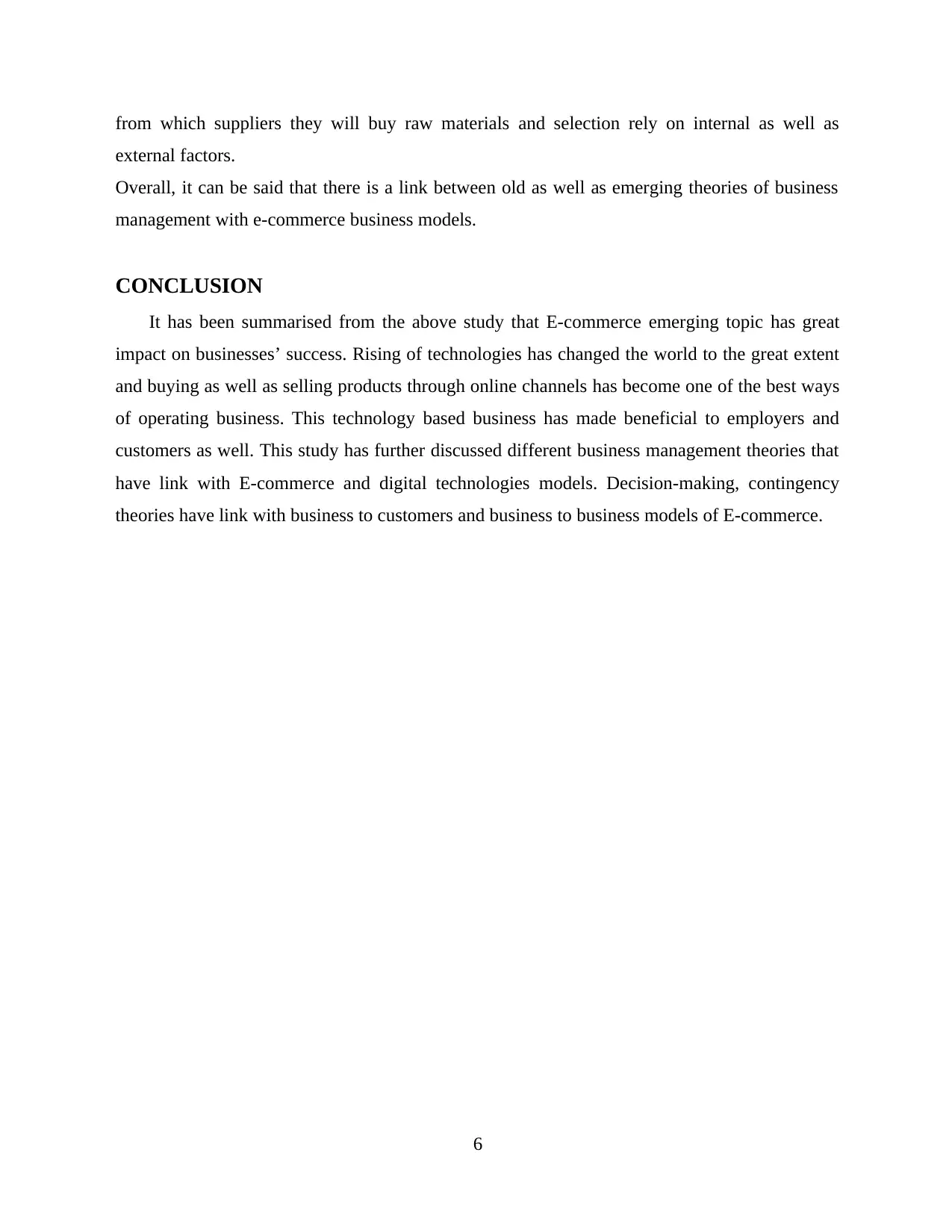
from which suppliers they will buy raw materials and selection rely on internal as well as
external factors.
Overall, it can be said that there is a link between old as well as emerging theories of business
management with e-commerce business models.
CONCLUSION
It has been summarised from the above study that E-commerce emerging topic has great
impact on businesses’ success. Rising of technologies has changed the world to the great extent
and buying as well as selling products through online channels has become one of the best ways
of operating business. This technology based business has made beneficial to employers and
customers as well. This study has further discussed different business management theories that
have link with E-commerce and digital technologies models. Decision-making, contingency
theories have link with business to customers and business to business models of E-commerce.
6
external factors.
Overall, it can be said that there is a link between old as well as emerging theories of business
management with e-commerce business models.
CONCLUSION
It has been summarised from the above study that E-commerce emerging topic has great
impact on businesses’ success. Rising of technologies has changed the world to the great extent
and buying as well as selling products through online channels has become one of the best ways
of operating business. This technology based business has made beneficial to employers and
customers as well. This study has further discussed different business management theories that
have link with E-commerce and digital technologies models. Decision-making, contingency
theories have link with business to customers and business to business models of E-commerce.
6
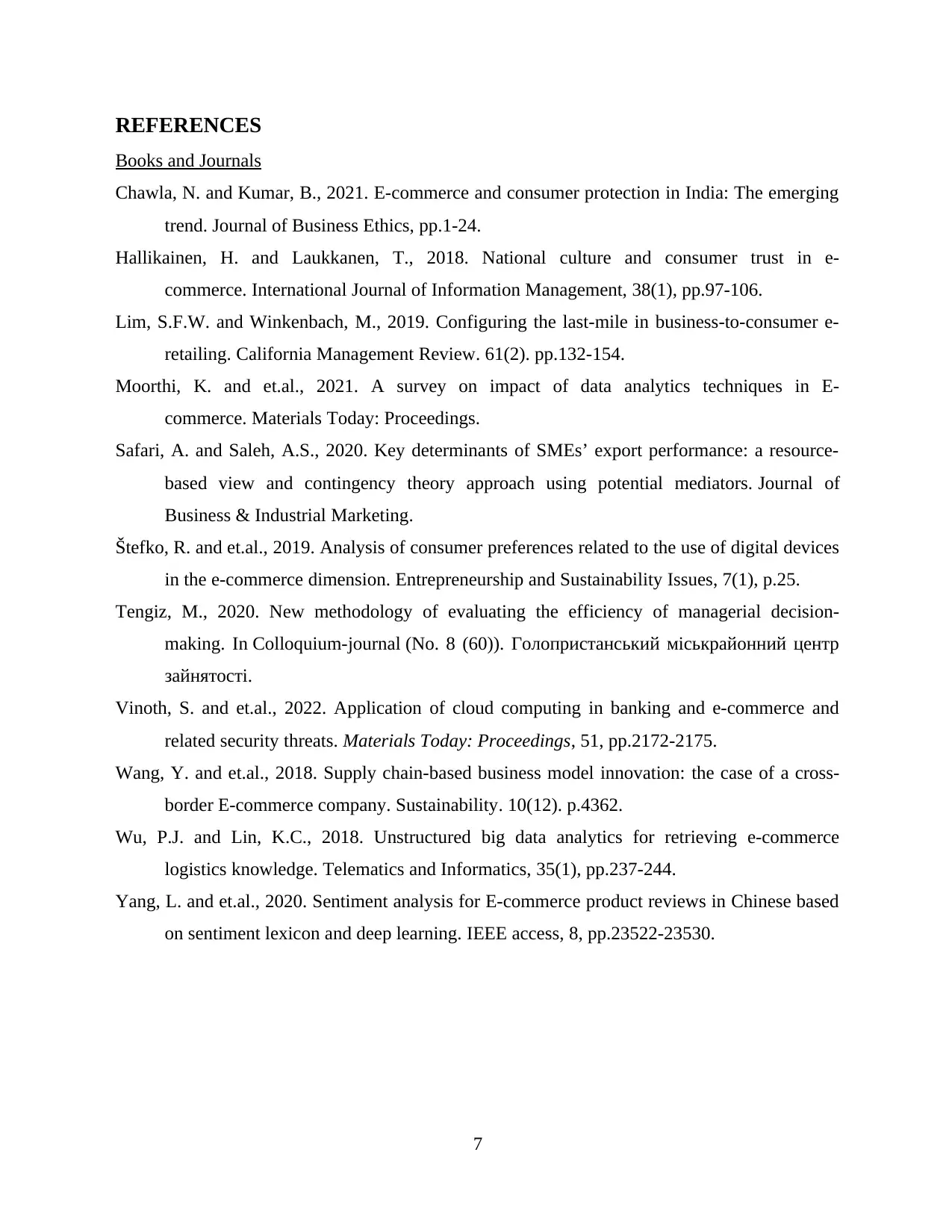
REFERENCES
Books and Journals
Chawla, N. and Kumar, B., 2021. E-commerce and consumer protection in India: The emerging
trend. Journal of Business Ethics, pp.1-24.
Hallikainen, H. and Laukkanen, T., 2018. National culture and consumer trust in e-
commerce. International Journal of Information Management, 38(1), pp.97-106.
Lim, S.F.W. and Winkenbach, M., 2019. Configuring the last-mile in business-to-consumer e-
retailing. California Management Review. 61(2). pp.132-154.
Moorthi, K. and et.al., 2021. A survey on impact of data analytics techniques in E-
commerce. Materials Today: Proceedings.
Safari, A. and Saleh, A.S., 2020. Key determinants of SMEs’ export performance: a resource-
based view and contingency theory approach using potential mediators. Journal of
Business & Industrial Marketing.
Štefko, R. and et.al., 2019. Analysis of consumer preferences related to the use of digital devices
in the e-commerce dimension. Entrepreneurship and Sustainability Issues, 7(1), p.25.
Tengiz, M., 2020. New methodology of evaluating the efficiency of managerial decision-
making. In Colloquium-journal (No. 8 (60)). Голопристанський міськрайонний центр
зайнятості.
Vinoth, S. and et.al., 2022. Application of cloud computing in banking and e-commerce and
related security threats. Materials Today: Proceedings, 51, pp.2172-2175.
Wang, Y. and et.al., 2018. Supply chain-based business model innovation: the case of a cross-
border E-commerce company. Sustainability. 10(12). p.4362.
Wu, P.J. and Lin, K.C., 2018. Unstructured big data analytics for retrieving e-commerce
logistics knowledge. Telematics and Informatics, 35(1), pp.237-244.
Yang, L. and et.al., 2020. Sentiment analysis for E-commerce product reviews in Chinese based
on sentiment lexicon and deep learning. IEEE access, 8, pp.23522-23530.
7
Books and Journals
Chawla, N. and Kumar, B., 2021. E-commerce and consumer protection in India: The emerging
trend. Journal of Business Ethics, pp.1-24.
Hallikainen, H. and Laukkanen, T., 2018. National culture and consumer trust in e-
commerce. International Journal of Information Management, 38(1), pp.97-106.
Lim, S.F.W. and Winkenbach, M., 2019. Configuring the last-mile in business-to-consumer e-
retailing. California Management Review. 61(2). pp.132-154.
Moorthi, K. and et.al., 2021. A survey on impact of data analytics techniques in E-
commerce. Materials Today: Proceedings.
Safari, A. and Saleh, A.S., 2020. Key determinants of SMEs’ export performance: a resource-
based view and contingency theory approach using potential mediators. Journal of
Business & Industrial Marketing.
Štefko, R. and et.al., 2019. Analysis of consumer preferences related to the use of digital devices
in the e-commerce dimension. Entrepreneurship and Sustainability Issues, 7(1), p.25.
Tengiz, M., 2020. New methodology of evaluating the efficiency of managerial decision-
making. In Colloquium-journal (No. 8 (60)). Голопристанський міськрайонний центр
зайнятості.
Vinoth, S. and et.al., 2022. Application of cloud computing in banking and e-commerce and
related security threats. Materials Today: Proceedings, 51, pp.2172-2175.
Wang, Y. and et.al., 2018. Supply chain-based business model innovation: the case of a cross-
border E-commerce company. Sustainability. 10(12). p.4362.
Wu, P.J. and Lin, K.C., 2018. Unstructured big data analytics for retrieving e-commerce
logistics knowledge. Telematics and Informatics, 35(1), pp.237-244.
Yang, L. and et.al., 2020. Sentiment analysis for E-commerce product reviews in Chinese based
on sentiment lexicon and deep learning. IEEE access, 8, pp.23522-23530.
7
⊘ This is a preview!⊘
Do you want full access?
Subscribe today to unlock all pages.

Trusted by 1+ million students worldwide
1 out of 9
Related Documents
Your All-in-One AI-Powered Toolkit for Academic Success.
+13062052269
info@desklib.com
Available 24*7 on WhatsApp / Email
![[object Object]](/_next/static/media/star-bottom.7253800d.svg)
Unlock your academic potential
Copyright © 2020–2025 A2Z Services. All Rights Reserved. Developed and managed by ZUCOL.





